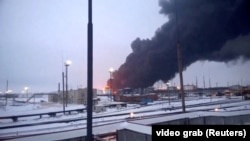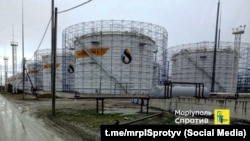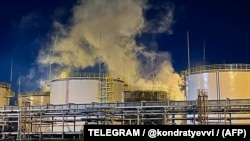On May 19, a Ukrainian drone slammed into the 70,000-barrel-a-day Slavyansk oil refinery in southern Russia’s Krasnodar region, sending a fireball into the sky, according to videos circulating on social media.
It was the third time in two months that Ukrainian forces hit the relatively small plant located several hundred kilometers from the front, dodging Russian air defense systems. The latest strike forced Slavyansk to temporarily shut down until the damage could be repaired.
The hits on the refinery were part of a campaign of drone strikes on energy infrastructure inside Russia that Ukraine has carried out in defiance of the United States, which has urged Kyiv not to target such facilities as it defends itself against a full-scale invasion now well into its third year.
The U.S. objections are related to a broader and increasingly heated debate over whether Ukraine should attack targets in Russia, particularly when it is using weapons provided by the West.
Following a spate of successful Ukrainian drone attacks on refineries earlier this year, Artyom Verkhov, a Russian Energy Ministry official, told parliament in March that there were plans to protect some oil and gas infrastructure with missile systems. Meanwhile, companies began taking matters into their own hands amid a reported shortage of air defenses, setting up mobile air defense groups armed with machine guns, anti-aircraft guns, and electronic warfare weapons as well as covering potential targets with metallic nets.
But in the cat-and-mouse game of drone and anti-drone innovation, Ukraine’s rapid technological advances and growing output of unmanned aircraft is keeping it one step ahead of Russia’s defenses, analysts say, leaving the Kremlin’s vast energy infrastructure network in European Russia vulnerable.
Eduard Trudnyev, a Slavyansk security official, told Russian state news agency TASS that Ukraine used bigger and more powerful drones in the most recent strike than in previous attacks on the plant.
Ukraine has invested heavily in the development and production of long-range drones with heavier payloads and lower susceptibility to jamming. Some can hit targets more than 1,000 kilometers from the front lines.
That puts about half of Russia's refining capacity within striking distance, experts say. While it would be virtually impossible for Ukraine to knock out all that capacity at the same time, the intermittent attacks are a headache for the Kremlin and its energy industry.
The strikes “create uncertainty,” Olga Khakova, an energy security analyst at the Atlantic Council, a U.S. think tank, told a conference on May 23. The campaign of attacks “forces Russia to think about how to protect these critical energy infrastructure installations.”
Russia has concentrated its air defenses along the front lines and the border with Ukraine to focus on protecting the Ukrainian airspace under its control and military bases in Russian border areas, said George Barros, an analyst at the Washington-based Institute for the Study of War (ISW).
“It doesn't make a whole lot of sense to have those systems laid out like polka dots on the interior of your country, especially one as vast as Russia. You really intercept these sorts of threats at the borders of your airspace, not the interior,” Barros said.
Andrei Kartapolov, chairman of the Russian parliament’s defense committee, said last year that Russia only had enough air defense assets in the interior to protect important government and military facilities and recommended companies acquire their own capabilities.
Dara Massicot, a military analyst at the Carnegie Endowment for International Peace, said Russia might choose to move air defense systems located in the Far East and Arctic, where there is no immediate threat, to the central regions to protect some facilities there.
Rapid Rebound
Ukraine has now carried out more than 20 attacks on Russian refineries and energy infrastructure so far in 2024, temporarily knocking out 14 percent of capacity at the peak in late March.
Some refineries, like Slavyansk and Tuapse, also in the Krasnodar region, have been hit more than once, underscoring the difficulty of protecting such facilities, especially when drones are launched in large numbers. Ukraine launched at least 57 into the Krasnodar region on May 18-19, according to Russia.
After the first series of refinery strikes at the start of the year, Russia imposed a six-month ban on the export of gasoline, effective March 1, in an effort to ensure the domestic market is fully supplied and prices stay low. Like many governments, Russia’s fears that high gasoline prices could trigger social discontent.
In targeting refineries, Ukraine is seeking to curtail Russian oil export revenue, the single biggest source of money for the federal budget, and to disrupt the domestic fuel market, experts say. Some experts say the impact will be minor because Russia’s oil industry has flexibility built into its structure.
Russia on average refines more than 5 million barrels of oil a day, far outstripping domestic demand, allowing it to cut exports in the face of a fuel price spike. Since the start of the war in February 2022, Russia has temporarily banned gasoline exports on more than one occasion to ensure price stability at home.
Overall, Russia has a refining capacity of about 6.5 million barrels a day, according to the Britain-based Oxford Institute for Energy Studies, so it can use this spare capacity to absorb shutdowns. It also has the option of pushing back seasonal maintenance at some refineries if others are knocked offline.
Russia can also export more crude in lieu of refined products, offsetting revenue losses. Total Russian oil export revenue declined only marginally in April, as higher crude export volumes and higher oil prices largely offset a 16 percent decline in revenue from oil product exports, according to the Finland-based Centre for Research on Energy and Clean Air (CREA).
Russia has been able to repair some of the damage to its refineries quicker than many expected. In a sign of a rapid rebound, Russia announced it would resume gasoline exports from May 20 to June 30 amid excess stock at refineries and ports.
In a monthly market update on May 15, the International Energy Agency said Russia’s refineries have so far avoided significant production losses, adding that it initially overestimated the impact on second quarter output.
Russia’s May refining level is estimated at 5 million barrels a day, the IEA said in a statement to RFE/RL. It would be between 5.2-5.3 million barrels a day without the strikes, implying a loss of just 4 to 6 percent.
“The reported damage, while widespread does not appear to have disrupted processing rates to the extent we had anticipated and some refineries started up sooner than we had assumed,” the IEA said in its statement to RFE/RL.
Sergei Vakulenko, the former head of strategy and innovations at Russian state-owned oil company Gazpromneft, said the Ukrainian strikes are more a nuisance than a calamity.
“Attacks on the Russian refining sector do create losses for Russia, but so far it has been mostly ‘bothering fire,’ Vakulenko, who is now an analyst at the U.S.-based Carnegie Endowment for International Peace, wrote in a May 9 post on Substack. “It has not been material. It has not created any shortages of fuels. It did not have serious effects on fuel prices in Russia.”
Morale Booster
But the attacks are a morale-booster for Ukraine, and a display of its capabilities against the much larger invader. Moreover, experts say that if Ukraine keeps up the strikes on refineries, Russia could increasingly struggle to repair them in a timely fashion due to U.S. and European sanctions, experts say. Russia’s oil refining industry is dependent on Western technology for some of its advanced processes.
While the strikes haven’t had a massive impact yet, effects could manifest themselves in the longer run, said Isaac Levi, an analyst at CREA.
Continued strikes could also put pressure on Russia’s expansive rail network if gasoline and diesel products must be shipped thousands of kilometers westward from refineries in the Urals and Siberia, experts say.
U.S. President Joe Biden’s administration has urged Ukraine to stop targeting Russian refineries amid concerns it could push oil prices up at a time when inflation in many parts of the world is still high. Russia is one of the world’s largest exporters of refined oil products.
U.S. Defense Secretary Lloyd Austin told the Senate Armed Services Committee that attacks on refineries could have "a knock-on effect in terms of the global energy situation." Ukraine is "better served in going after tactical and operational targets that can directly influence the current fight," he said.
So far, there has been no substantial impact on global markets. Oil prices were trading near a three-month low on May 28.
Ukraine says refineries are legitimate targets and does not seem to be heeding the U.S. requests.
Kyiv is likely to be able to continue to mount successful strikes on Russia’s energy industry despite Moscow’s attempts to boost defenses, experts say.
Ukraine has been slowly degrading Russia’s air defenses, opening some gaps in coverage. And with production of long-range drones growing, it can launch a greater number of them into Russian territory at the same time, saturating air defenses.
“If the Ukrainians can launch a high volume of long-range drones, then even with a low success rate they are bound to pull off successful strikes,” the ISW’s Barros said.
















